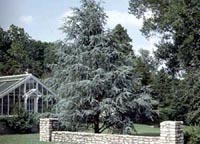Resource Library
Plant of the Week: Blue Atlas Cedar
The University of Arkansas System Division of Agriculture does not promote, support or recommend plants featured in "Plant of the Week." Please consult your local Extension office for plants suitable for your region.
Plant of the Week
Blue Atlas Cedar
Latin: Cedrus atlantica 'Glauca'

Trees of exceptional grace and beauty are a welcome addition to any landscape, but
sometimes gardeners forget the operative word is "tree" and put these specimen plants
in impossible locations.
One of the plants I frequently see poorly sited is the Blue Atlas Cedar. Because
they have such an interesting and picturesque habit while young the tendency is to
locate them where they simply do not have enough room to express themselves as they
age.
The Blue Atlas Cedar is a stiffly upright tree that is grown widely by West Coast
nurseries and is becoming increasingly common in our nurseries. As a youngster the
tree is stark -- almost looking more like a piece of modern art sculpture than a plant
-- but eventually it grows into a 60-foot tall tree that can be 35-feet across. So,
obviously siting is critical.
The trees are pyramidal while young but with age become flat topped with horizontal
branches. The evergreen needles are a light blue gray color, individually 1-inch long
but borne on short spurs in tufted clusters. When compared to the closely related
Cedar of Lebanon (C. libani) the leaves and upright cones of the Blue Atlas Cedar are smaller.
The Blue Atlas Cedar is native to the Atlas Mountains which form a 12,000-foot wall
from west to east across the northwest corner of the African continent in Morocco
and Algeria. The Atlas Cedars were not discovered until 1827 when P.B. Webb, an English
botanist, visited Tangier and was shown a branch collected by a native from the interior
of the range. The trees occur between 4,000 and 7,000 feet and are one of the principle
conifers of the mountain range where they occur in widely scattered stands.
The blue color to the leaves is due to a wax deposit which occurs on many species
of conifers which grow in areas frequented by severe drought.
In England, this tree is one of the most spectacular trees in many of the old gardens
where 100-foot tall specimens are common. It was apparently introduced into cultivation
about 1840 and probably made its way to this country about that same time. Several
garden forms have been selected including a bizarre weeping form called ‘Glauca Pendula’
which has branches that droop from its few main limbs like icicles from a roof in
winter.
In the garden, the Blue Atlas Cedar shows the growth habit of the typical American
male, it grows quickly in height, to 20 feet, and then begins to spread out. It is
the most cold hardy of the true cedars and will grow as far north as St. Louis and
Boston.
The plant grows best in better soils but is not especially finicky about soil type.
Once established it has great drought tolerance. Fortunately it also tolerates heat
as well as cold and does not seem to resent our summer humidity. It can be grown throughout
the state as a landscape specimen but must be situated at least 20 feet away from
buildings or its nearest neighbor.
By: Gerald Klingaman, retired
Extension Horticulturist - Ornamentals
Extension News - February 4, 2000
The University of Arkansas System Division of Agriculture does not maintain lists of retail outlets where these plants can be purchased. Please check your local nursery or other retail outlets to ask about the availability of these plants for your growing area.